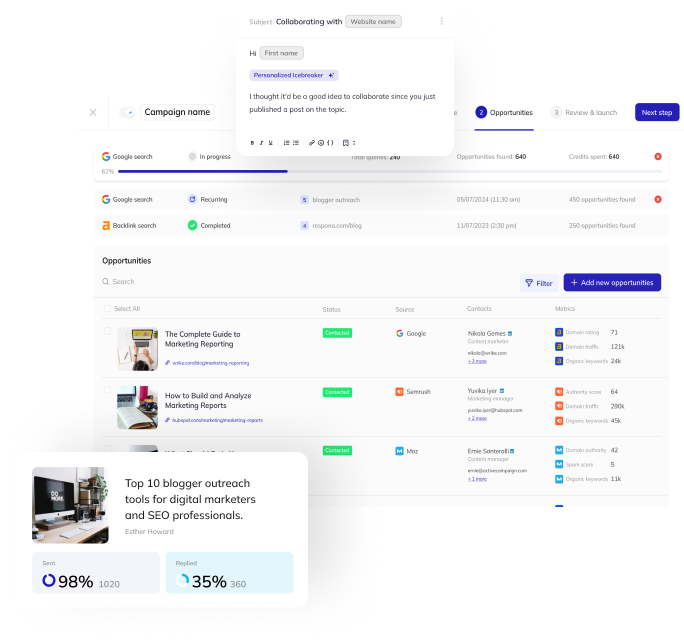Blogger outreach is an integral part of countless companies’ business operations.
But what really is it and how do you do it?
In this blog post, we will be discussing:
- What is blogger outreach and what it’s used for
- The difficulties that come with running blogger outreach campaigns
- The step-by-step process for running a blogger outreach of any kind
- Templates for 11 kinds of blogger outreach
Let’s get into it.
- What is Blogger Outreach?
- Does Blogger Outreach Still Work in 2024?
- What Are the Different Types of Blogger Outreach?
- Downsides of Blogger Outreach
- Is Blogger Outreach Spam?
- Step-By-Step Process for Running a Blogger Outreach Campaign
- 11 Blogger Outreach Templates
- Now Over To You
- Frequently Asked Questions (FAQ)
Link building cheat sheet
What is Blogger Outreach?
Blogger outreach is a modern-day inbound marketing strategy used to promote a brand through leveraging the influence of relevant bloggers or influencers.
It’s a mutually beneficial relationship between a company and a blogger, in which the company provides the blogger with freebies, prizes, or even services in exchange for a product review, a branded mention, or a quality backlink.
In other words, it’s a way of connecting with the right individuals who have the potential to boost the brand’s presence and visibility.
Does Blogger Outreach Still Work in 2024?
It’s clear that in 2024, blogger outreach is still going to be an effective strategy if you are willing to put in the effort to make it happen.
Backlinko’s research has shown that only 8.5% of outreach emails get a response.
This may seem discouraging at first, but it shouldn’t prevent you from doing blog outreach at all.
The reason why blogger outreach gets a bad rep is because of emails like this:
Most of these messages don’t even make it to the recipients’ inboxes, instead being filtered out by spam filters.
By personalizing each email and creating a clear outreach strategy, you can make sure that your emails stand out from the crowd and get the response you’re looking for.
In fact, some of our best-performing blogger outreach campaigns had a reply rate of upwards to 30% reply rate, which is a stark contrast to the 8.5% average.
What Are the Different Types of Blogger Outreach?
Now, let’s look at some specific applications of blogger outreach in real life.
Link Building
Link building is the bread and butter of marketing, and it’s no wonder companies are turning to blogger outreach for the task.
After all, what’s not to love with the boost in domain authority (DA) and the side benefit of referral traffic?
Link building can be a tedious process, but it’s an important one if you want to rank higher in the SERPs.
Thankfully, there are tools available to help streamline the process and save you time and money – like Respona! So, let’s keep moving forward with the next type of outreach.
Content Promotion
One of the most effective ways to get your content out there is through influential blogger outreach.
Finding the right influencers in your niche who can help you spread the word about your content can be a great way to make sure you reach more people.
It’s a simple process: you find the right blogger with a loyal and engaged target audience and they promote your content through their various channels.
This way, you can be sure your content is reaching the right people and that your content marketing efforts are being maximized.
Blogger outreach can help your content promotion process in a variety of ways:
- By helping you reach new outlets for content syndication
- Speed up your content distribution
- Leverage never-tapped-in-before audiences
On to the next type of blogger outreach
Partnerships and Collaborations
Connecting with industry professionals through blogger outreach is one of the most effective ways of building relationships with influencers, newbies, and trend-setters.
Doing so can help you expand your reach, boost your social shares, establish meaningful relationships, and come up with creative collaboration and partnership opportunities, such as co-hosting webinars, sponsored posts, or writing guest content for each other.
It’s easier than ever to get in touch with people who can help – all you need is a great LinkedIn connection or a persuasive follow-up email.
But why should you even bother forming collaborations and partnerships if your business is already producing high-quality content, innovative infographics, or has an outstanding service?
The answer is simple: no matter how great your business is, you need people to actively support it and spread the word. And it’s really hard to do that on your own.
Product/Service Promotion
It’s no secret that working with bloggers to promote your product or service can have major payoffs.
Your strategy could include case studies and product reviews, and influencer marketing on high-profile sites and social media groups, which could bring increased organic traffic, quality backlinks, and brand awareness.
Not to mention, a higher follower count and more visibility on social media. Ultimately, effective blogger outreach can help capture the attention of potential customers and increase sales.
Statistics show that nearly half of Twitter users trust influencer recommendations when it comes to purchasing decisions.
So, if you’re looking to get the most out of your marketing efforts, blogger outreach should be on your agenda.
Take the time to craft an effective strategy and watch your brand reap the rewards.
Sniper vs Shotgun Outreach
Now that we’ve talked about the different purposes of blogger outreach campaigns, there are two more types of blogger outreach that you need to be aware of.
These are more like approaches to blogger outreach rather than types in the same sense as described above.
The sniper approach is all about being precise and surgical with your outreach effort. It requires a lot of research and careful targeting of specific popular bloggers who have a great deal of influence in your niche.
It involves creating a list of highly relevant and influential bloggers and then crafting personalized messages to each one. The aim is to have a very high success rate in terms of responses and meaningful relationships.
It’s much more time-consuming than the shotgun approach and is usually reserved fir high-value promotion and collaboration outreach.
The shotgun approach, on the other hand, is much less precise and involves sending out a large number of generic messages to a large number of bloggers.
The success rate with this approach is much lower than with the sniper approach, but it is much faster and easier to execute.
The downside is that you may end up sending out a lot of messages that are completely irrelevant to the bloggers you’re contacting, making it difficult to build meaningful relationships.
The shotgun approach is typically used for link building.
Downsides of Blogger Outreach
Now that we know the benefits and types of blogger outreach, let’s discuss some of the issues that you need to be ready to face if you decide to invest in blogger outreach.
Time-Consuming
The first one is just the amount of time it takes from start to finish.
A single blogger outreach involves four steps:
- Finding prospects (websites, specific articles, or specific people)
- Preparing your email sequence
- Finding actual contact email addresses
- Personalizing each message for every single prospect
Respona was built specifically to reduce the amount of manual input needed at every step (especially prospecting and finding contact information), however, even with the best automation in the world, you’ll still be looking at at least a couple of hours for a blogger outreach campaign with around one hundred messages.
Works best at scale
Now, remember the average reply rate for outreach emails? That’s right, only eight messages out of that hundred will elicit any kind of response.
And roughly half of those responses will be negative, decreasing the success rate even lower.
So, logically, to get better results, you need to send more emails.
For long-term activities such as link building, blogger outreach never truly ends – you may find your team sending hundreds of emails per week for months and even years.
So, when determining your strategy, keep in mind how much time and roughly how many emails it’s going to take to achieve your goals.
Can hurt your domain reputation
Because of the sheer amount of emails that may be sent as part of a blogger outreach campaign, there’s always a risk of triggering spam filters or even getting manually reported as spam.
Of course, this is bad-bad for your email domain reputation.
Taking a hit to your domain reputation will reduce your inbox deliverability and greatly increase the likelihood of any further emails sent by you ending up right in your recipients’ spam folder or even rejected entirely by the ESP.
Recovering from such a hit is a lengthy process – one that you may not be able to afford to lose time on if you rely on your email domain for other types of outreach; for example, sales.
Is Blogger Outreach Spam?
Blogger outreach is often considered spam by its recipients because of unpersonalized, mass email blasts.
When carried out with the care and attention that it should be, blogger outreach is not.
However, junior outreach teams often make the same mistakes that land their pitches directly in the spam folders.
Let’s take a look at the exact properties that can make a legitimate blogger outreach spammy.
It contains spam words
The first on our list are, of course, spam words.
These include your obvious “buy now”, “register for free”, “limited time offer”, etc.
However, these are just a few of the most common spam words out there.
In reality, there are countless words and phrases that don’t even sound spammy but can trigger spam filters.
It’s impossible to keep all of them in your memory, and many outreach people make the mistake of not running their messages through a spam word checker before sending.
Respona actually comes with a built-in spam word checker of its own, along with an estimator of how likely your email is to get a response, based on its subject and body length, along with its question count.
Your email domain lacks proper authentication
The second mistake inexperienced personnel makes is to dive straight into sending email campaigns without first ensuring proper authentication for their email domain.
Not setting up the following protocols almost always results in poor deliverability from the get-go along with exceptionally high spam rates.
DKIM (DomainKeys Identified Mail) is an email authentication system that uses digital signatures to validate the authenticity of a message.
It allows an email sender to add a special cryptographic signature to outgoing messages that can be used by receivers to verify that the message was actually sent by the sender, and not a third party.
DKIM is also used to protect against spoofing, by ensuring that the message was not modified in transit.
DMARC (Domain-based Message Authentication, Reporting & Conformance) is an email authentication system that builds on the DKIM and SPF protocols by giving receivers more detailed information about the message and how it should be handled if it fails the authentication checks.
DMARC also provides receivers with a way of reporting back to the sender any issues encountered, so that the sender can identify and fix any problems.
SPF (Sender Policy Framework) is an email authentication system that allows an email sender to specify which IP addresses are allowed to send mail from their domain.
This allows receivers to verify that the mail they receive from a given domain is actually from that domain, and not from a third party.
For instructions on how to enable these protocols for your email domain, refer to our help center.
You didn’t warm up your emails
Even after setting up DKIM, DMARC, and SPF, you can’t go straight to sending hundreds of emails per day.
You need to warm up your email accounts first.
Email warmup refers to the process of starting at a low daily email limit and slowly increasing it week over week until you reach your target daily limit.
We recommend starting at 10-15 daily emails and working your way up to 50 over the course of a month.
This allows you to slowly build up some email reputation and make your sending patterns much more natural in the eyes of email service providers.
You sent too much
This is probably the biggest mistake outreach teams make.
Yes, blogger outreach is a numbers game, and the number of emails sent is directly tied to the number of opens and replies.
Also, if you’re running a large-scale outreach campaign with thousands of people to reach out to, it may not be feasible to settle for a low daily email limit.
You should keep in mind that sending hundreds of emails from a single sender account for extended periods of time will gradually decrease your domain reputation, and slowly but surely drive your deliverability into the ground, as your spam rates soar.
So what do you do?
The trick is simple: create several sender emails, warm them up, and distribute your campaign to multiple emails with a lower daily email limit (ideally 50 or lower) rather than blast hundreds of messages from a single account.
Your message is generic
We already shared one example of a bad blogger outreach email.
Let’s take a look at another example.
Notice the similarities?
Most of these emails pitch a guest post or link exchange without any sort of personalization or value proposition, which are the most important elements of a blogger outreach email.
So, unless you add at least a single personalized line to your own emails, you’ll likely be viewed as one of these people, and completely ignored if not reported as spam.
You didn’t connect on social media
Blogger outreach has such a low success rate because it’s “cold” outreach.
This means that you’re reaching out to people that you have never interacted/communicated with before.
And, we as humans, are naturally skeptical of people you don’t know.
So, another step of getting yourself out of spam hell is to adopt a simple strategy: sending your prospects a connection request on LinkedIn before sending them an email.
The goal for this is straightforward: attach a face to your outreach so it’s not as cold anymore.
This way, you’re more likely to elicit a response with your email.
Now, let’s take a look at how to actually set up and run a blogger outreach campaign of your own.
Step-By-Step Process for Running a Blogger Outreach Campaign
In our example, we will be running a link building campaign with our blogger outreach tool, Respona.
More specifically, an anchor text strategy campaign targeting our guide on guest blogging.
The goal of this strategy is to find non-competing articles that mention your target keywords somewhere in the content, then reach out to them, asking them to add your link on a specific anchor text – hence the name.
Step 1 – Prospecting
First, we’re going to need to create a campaign.
Respona actually comes with a number of campaign templates for link building, as well as different types of blogger outreach and even podcast outreach.
Let’s pick the Link Insertion template.
As you can see, there are four fields to fill out:
- Content URL (the article you’d like to promote)
- Target keyword(s) – will be used by the search engine to find relevant opportunities
- Content description – a brief description of the article you’re promoting
- Incentive – what will your prospect get from collaborating with you (a social share or an indirect link back, for example)
The first target keyword along with the content description and incentive will be pulled directly into the pre-made email template, which you can see in the bottom left corner of the screen.
Once all fields are filled out, click “Use this template”.
You will be brought into the campaign editor.
As you can see, the search engine is already configured to find articles that mention your target keywords in the content but not in the title, making them perfect opportunities for the anchor text link building strategy.
There isn’t much you need to do here besides click “Continue”, set up any additional SEO filters you may need to weed out opportunities that don’t fit your target criteria, and wait for the search automation to do its magic.
Once the search automation is complete, you can review its results before moving on to the next steps.
Step 2 – Preparing your Email Sequence
Since we used a campaign template, we already have our email sequence pre-configured.
However, there are still a few things we can do here.
First, let’s change the delay of our follow-up message from 7 days to 5.
Next, let’s add an unsubscribe link to give our recipients an easy way to opt-out from further communications to reduce our chances of getting flagged as spam.
Finally, let’s check our email for spam words, just to be safe.
Looks like we have a pretty good chance of getting a response with this template, so let’s move to the next step.
Step 3 – Finding Contacts
Respona automates the process of finding contact emails almost completely.
All you have to do is tell the algorithm which employees at your target companies it should look for.
For link building purposes, let’s enter all positions related to content, marketing, SEO, and partnerships into the position field, at all seniority levels.
In the advanced settings, let’s also enable Respona to assign company generic emails if no personal emails are found for a website to increase the success rate of our automation.
Once everything is set up, let’s run the automation.
Depending on the size of your campaign, the contact search automation can take from a few minutes to a couple of hours.
The good thing is that it’s done completely in the cloud, so you don’t have to sit there and wait for it to finish – you can start working on another campaign or task in the meantime.
When it’s finished, of course, you can review its results and even run additional manual searches based on domain, name, or job title.
Once all contacts are assigned, move on to the final step.
Step 4 – Personalization
Before launching our outreach campaign, let’s add a personalized touch to every email to make sure our messages stand out from the crowd.
We can do so by referencing something our prospect has mentioned in the article, making it seem like we actually took the time to read through their content (even if we didn’t really).
Respona actually has a built-in AI that scrapes pages for brief summaries and important points that you can copy and paste directly into your emails for quick but deep personalization.
You can find them on the right side of the email editor.
Before launching the campaign, let’s run some final pre-launch safety checks to make sure none of our emails contain placeholders, and that we’re not trying to reaching out to any of our recent contacts or ones in our unsubscribe list.
11 Blogger Outreach Templates
Skyscraper Technique Link Building Template
Hi {first_name},
You referenced an older post on [target keyword] in your article.
We just released a brand new guide on the topic that would make a better fit.
[Content description]
[Incentive]
How does that sound?
[signature]
Resource Page Link Building Template
Hi {first_name},
I’m wondering whether you’re open to adding our new guide to your list of [Target keyword1] resources?
[Content description]
[Incentive]
Looking forward to hearing from you,
[Signature]
Listicle Link Building Template
Hi {first_name},
It seems like you missed [Company name] in your post on [target keyword1] :(
[Unique aspects of your company]
[Incentive]
How does that sound?
[Signature]
Anchor Text Link Building Template
Hi {first_name},
You briefly talked about [target keyword1] in your article.
We just released a comprehensive guide that would make a perfect addition.
[Content description]
[Incentive]
How does that sound?
[signature]
Guest Posting Template
Hi {first_name},
Would it be ok to send over a few topic ideas for your blog?
I’d love to do keyword research and find what terms your competitors are ranking for, but {Website_name} isn’t.
No strings attached if you didn’t like the topics.
P.S. Here’s an example of a piece I’ve written recently: [Example content URL]
[Signature]
Product Review Outreach Template
Hi {first_name},
Loved the review you did on [Competitor name]. It’s very thorough and well-researched.
I’m wondering if you’re open to writing a review for [Company name]?
[Unique aspects of your company]
[Incentive]
How does that sound?
[Signature]
Product Alternatives Outreach Template
Hi {first_name},
It seems like you missed [Company name] in your list on [Competitor name] alternatives :(
[Unique aspects of your company]
[Incentive]
How does that sound?
[Signature]
Podcast Outreach Email Template
Hi {first_name},
Just finished listening to your interview with [Influencer] and loved it!
I’m wondering if you’re open to accepting new guests on the show?
To give you a brief background, [Brief bio]
[Topic]
No pressure if you don’t think there’s a fit!
[Signature]
Infographic Outreach (Guestographic) Template
Hi {first_name},
Loved the new article you wrote on “[Target keyword1].” It’s very thorough and well-researched.
I just published an infographic on the topic and thought it might interest you.
[Infographic description]
Mind if I pass it along? Would love to get your take on it :)
[Singature]
Competitor Mention Email Template
Hi {first_name},
Since you mentioned [Competitor name] in your article, thought you’d be interested in checking out [Company name].
[Unique aspects of your company]
[Incentive]
How does that sound?
[Signature]
Content Syndication Email Template
Hi {first_name},
I’m wondering whether you’re open to syndicating our new [Target keyword1] guide on {Website_name}?
[Content description]
I’m happy to help drive traffic by sharing it on our social channels.
[Signature]
Link building cheat sheet
Now Over To You
So yes, blogger outreach still works quite well even in 2024.
And no, it is not spam – as long as you follow all of the tips outlined in this article.
We know how time-consuming and tedious manual outreach can be – which is why we have created Respona.
Don’t hesitate to start your 7-day free trial now to see how we can help with your blogger outreach campaigns, first-hand.
Frequently Asked Questions (FAQ)
What are the benefits of blogger outreach?
Blogger email outreach is a great way to get your brand, product, or service in front of a larger, more targeted audience. It is an effective way to increase brand awareness, build relationships, and create an engaged community of potential customers.
How to plan out a blogger outreach strategy?
Determine your goal, find prospects, prepare your email sequence, find contact information, and personalize.
Which type of blogger outreach is the most effective?
It depends on what your goal is – for SEO, the most effective type of blogger outreach is link building, while if you’re trying to boost some sales, affiliate outreach would be the pick.
How do you avoid landing in the spam folder?
Authenticate your email domain, check your pitches for spam words, personalize every message you send out, and spread your outreach campaigns over several sender emails with a low daily email limit.
Should you do outreach yourself or hire a blogger outreach agency?
Blogger outreach can be very time-consuming, but our recommendation is to conduct it in-house with the help of an outreach tool like Respona – this way, you have complete control over each step of the process, which simply isn’t something you get from using blogger outreach service agencies.







